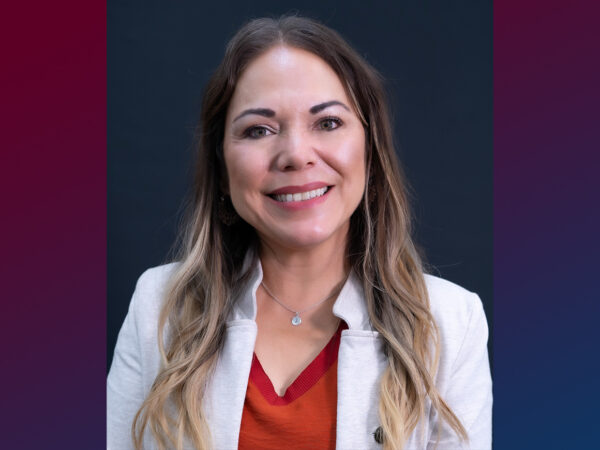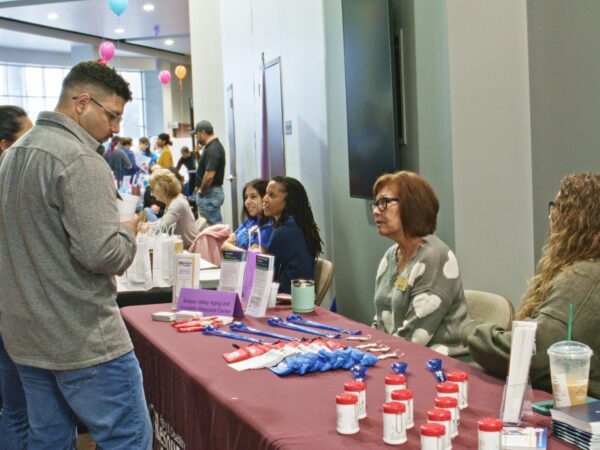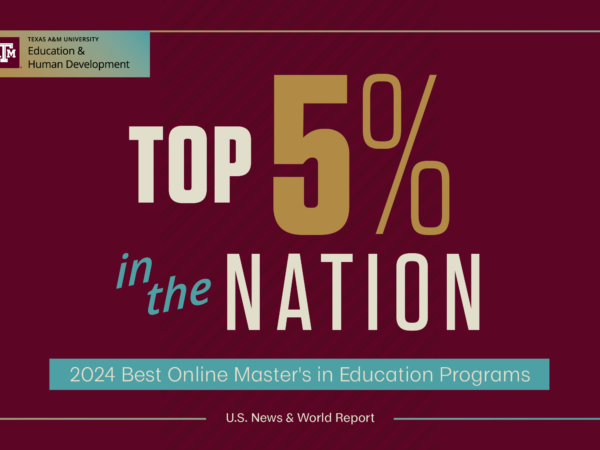The Language of Science
The college is closing the achievement gap for children who are learning English as a second language and improving early literacy skills for at-risk kindergarten students. Research has shown that early academic success forms the foundation for later success and higher scores in content specific areas, such as science.
Through programs and centers, we are serving the educational needs of adults who may have fallen through the cracks of the K-12 system, or received limited education, and finding solutions to reversing lagging graduation rates for Hispanic and African-American males.
CLOSING THE EDUCATIONAL ACHIEVEMENT GAP FOR ENGLISH LANGUAGE LEARNERS
In the Center for Research and Development in Dual Language and Literacy Acquisition (CRDLLA). closing the educational achievement gap for children who are learning English as a second language is the focus for researchers.
Led by co-directors Rafael Lara-Alecio and Beverly J. Irby, and associate director, Fuhui Tong, the center provides leadership in research, assessment, professional development and outreach to enhance the academic success of second language learners through programs that promote dual language and English language and literacy acquisition.
In Texas alone, more than 809,000 students were served in English language learner (ELL) programs in 2011-2012, according to the Texas Education Agency. Nationally, nearly 11.2 million school-aged children and their families are non-English speakers and 73 percent are Spanish speakers. Dropout rates among Hispanics/Latino are a major concern and are reported to be the highest among all ethnic groups, according to the National Center for Education Statistics.
Lara-Alecio wants to ensure that ELLs experience the same academic achievement and success in school as their mainstream peers. “About 16 percent of children attending schools in America come from homes where English is not the primary language,” says Lara-Alecio. “The CDRLLA research will help determine the best approaches, methodologies, and techniques to better prepare teachers to educate ELLs.”
“Ongoing observation and feedback to teachers is critical to improve ELLs’ educational outcomes. Therefore, we systematically observe educational practices of teachers and the cognitive demands they present to students,” says Irby.
“We observe the activity structures in the classroom, such as teacher lectures and demonstrations and whether the students are listening and performing as expected,” she explains.
CRDLLA promotes practical classroom observations, which are based on the only theoretical framework for observing bilingual classroom pedagogy, developed and published by professors Lara-Alecio and Richard Parker at Texas A&M in 1994. “Through this instrument, we have the opportunity to monitor quality instruction in a reliable and valid way,” says Lara-Alecio.
A $16.5 million award from the Office of Innovation and Improvement, U.S. Department of Education provides the major funding for project English Language and Literacy Acquisition-Validation. ELLA-V is the only ongoing, national validation study that is a randomized, control study for the improvement of education for ELLs and forms the foundation of the center’s work.
Tong oversees the data collection process and is partnering with a team at Johns Hopkins University to provide the statistical analyses and results as one component of the evaluation process of ELLA-V.
“Four of our publications will be included in the What Works Clearinghouse (WWC),” says Tong. The WWC is an initiative of the U.S. Department of Education’s Institute of Education Sciences and publishes proven scientific information on what works in education to improve student outcomes.
Based on the results of studies related to ELLs, the CRDLLA research team found that early academic success forms the foundation for later success and higher scores in content specific areas, such as science.
Currently, the CRDLLA is working with school districts across Texas, targeting those with large populations of Spanish-speaking students. “We will add other school districts and expand our online professional development opportunities for administrators and teachers through a partnership with Citrix Go-to-Meeting,” says Irby.
The Center will conduct a variety of studies including longitudinal studies, intervention studies, and studies of academic reading and writing or vocabulary development and content area instruction, particularly in the area of science.
Ultimately, the CRDLLA is a reflection of the mission of the TAMU land grant institution and officials expect it to impact educational and academic practice and policy at the state, national and international levels.
For more information:
- Dr. rafael Lara-Alecio at a-lara@tamu.edu or
- Dr. beverly Irby at irbyb@tamu.edu
IMPROVING EARLY LITERACY SKILLS FOR AT-RISK KINDERGARTEN STUDENTS
Early childhood development and learning is a pivotal time in a child’s life to build the proper foundation for good reading and writing skills.
To provide educators with practical methods to help improve literacy skills, Nathan Clemens, assistant professor of school psychology and principal research investigator, works with a team of professors in the college to monitor assessments for kindergarten students at risk for reading disabilities.
The four-year research project, Early Literacy Measurement Project (ELM) is funded in part by a recent $1.6 million dollar grant awarded in July by the U.S. Department of Education, Institute of Education Services. The project will monitor about 600 kindergarten students in Texas. The project is also a collaboration with Southern Methodist University (SMU). Approximately half of the data will be collected from the SMU site.
The overall goal of the research project is to investigate assessments that are currently used to monitor reading development of kindergarten students at risk for reading difficulties and to identify assessments that are most efficient and practical.
The team, which includes Shana Hagan-Burke, associate professor of special education, and Deborah Simmons, professor of special education and faculty in special education at SMU, are examining other factors such as a student’s ability to understand instructions and language proficiency.
“We expect this project to provide detailed information on kindergarten reading development that may help us as educators to understand the course of reading disabilities and, most importantly, ways to intervene reading difficulties,” says Clemens.
Throughout the school year, the team works with teachers to assess students’ overall reading skills, monitors and provide updates and progress reports. They conduct brief assessments with the students in the first and second grade school years. The follow-up evaluations will provide information on the ability of kindergarten assessments to predict long-term reading outcomes.
“One assessment that is commonly used is a letter sound fluency test, where a student is asked to look at a page of letters and then say aloud the sounds each letter makes. Other assessments may have the student read short words or sentences,” says Clemens. “We don’t have a lot of information regarding how those measure function for students with reading difficulties. In part, that is what inspired this project,” he says.
The project and the rich data set will help measure the progress of students at risk and provide teachers feedback on a frequent basis. It will also reveal what early literacy looks like for students with reading difficulties throughout kindergarten and beyond.
CLOSING THE GAP: A CHANGING POPULATION
Texas gained more people than any other state from July 2011-July 2012, according to the Census Bureau, and a growing population means added demands on the education system. The state’s population increased by 3.6 percent from 2010-2012, bringing the total count to more than 26 million, second only to California.
And the demographics are changing, too. The non-Anglo population, most notably Hispanics, is growing, while the Anglo population has declined. The Texas State Data Center estimates that Hispanics will become the majority by 2020.
This shift is of particular concern when it comes to education, as researcher Luis Ponjuan, a professor in the Department of Educational Administration and Human Resource Development, is finding as he studies the growing achievement gap between males and females in college, specifically Hispanic and African-American males.
Ponjuan is exploring the reasons why Hispanic and African-American men are less likely than other males to attend college. He says although Hispanics are the fastest-growing ethnic group in Texas, they are the least likely to participate in higher education.
“This gap between what will be needed in our educated workforce and where we are currently as a nation is severe,” he adds.
A downward trend in college completion rates for Hispanics and African-American males is a long-standing concern for higher-education advocates and researchers. The Texas Higher Education Coordinating Board (THECB) is callig for statewide efforts to increase college participation and success for Hispanic and African-American males.
Ponjuan serves as chief external evaluator for the Texas Education Consortium for Males Students of Color Consortium, which is based within the division of diversity and community engagement at the University of Texas at Austin. With funding from the Greater Texas Foundation, TG Foundation, the THECB and private support, the consortium hopes to reverse the trend and serve as a professional networking community to strategize and find solutions to lagging graduation rates for Hispanic and African-American males.
18 school districts, community colleges and public universities – including Texas A&M, have joined the consortium in an effort to improve educational outcomes for minority males. “This collaborative project allows the state’s two leading research institutions to leverage resources and advance the Latino and African American male educational agenda at the state and national levels,” Ponjuan says.
According to a 2011 report released by CompleteCollege.org, 60 percent of the Texas workforce will require some type of post-secondary credential by the year 2020, and currently, only 31 percent of the Texas workforce has that level of education.
“This gap of almost 30 percent is huge – there’s no way to tell what the overall impact is going to be on the Texas economy,” says Ponjuan. But without an education, he says, “there are few options to move up the economic ladder.”
DEVELOPING ADULT LITERACY SKILLS
According to the National Research Council in 2012, 43 percent of the adult population in the United States only have basic and below basic literacy skills. These individuals can perform only the most basic literacy tasks and therefore may not function well in the workplace or as partners in their children’s education.
A large part of literacy concerns in Texas range from undereducated adults, different economic disadvantages, large gaps between education periods or challenges unique to English language learners.
Therefore, it is equally important to ensure that adult citizens possess the basic literacy skills to be self-sustaining throughout their lifetimes. The Texas Center for Advancement of Literacy and Learning (TCALL) is working with a variety of state and local entities to support adult and family literacy programs.
In 2013, the Texas Workforce Commission (TWC) became responsible for the state’s Adult Basic Education system. With that change, their overall goal is to prepare adult citizens with literacy skills for career mobility and sustainability to be able to be part of an ever-evolving workforce with new job demands and qualifications.
The TWC recently awarded a $4.6 million, two-year contract to TCALL for its new Texas Research-based Adult Instruction Network Professional Development Consortium (TRAIN PD). The formation of the consortium is an innovative approach to providing key services to more than 2,500 adult education and literacy professionals statewide. TRAIN PD will help ensure that adult educators have access to knowledge, resources, technology, networking opportunities and program support when seeking to enhance the instruction of students who are working to improve their English language skills, obtain a GED diploma, broaden career opportunities or enroll in an institution of higher learning.
“As adult education has moved under the Texas Workforce Commission and new and exciting partnerships with workforce centers begin to develop, TCALL is in an excellent position to continue serving the needs of Texas adults and support the efforts to enhance workforce skills,” says Federico Salas-Isnardi, literacy specialist and TCALL program coordinator. Salas-Isnardi works with center director Harriet Smith and Dr. Mary V. Alfred, principal investigator to coordinate efforts between TCALL and literacy programs.
Based on the results of studies related to English Language Learners, researchers from the Center for Research and Development in Dual Language and Literacy Acquisition found that early academic success forms the foundation for later success and higher scores in content-specific areas, such as science.
In Texas alone, more than 809,000 students were served in English language learner (ELL) programs in 2011-2012, according to the Texas Education Agency. Nationally, nearly 11.2 million school-aged children and their families are non-English speakers and 73 percent are Spanish speakers. Dropout rates among Hispanics/Latinos are a major concern and are reported to be the highest among all ethnic groups, according to the National Center for Education Statistics.
Today, TCALL is the resource and information hub that supports all publicly funded or community-based non-profit adult literacy programs in the state, and several state and federal professional development initiatives for adult educators. As the state literacy resource center, TCALL works to connect adult literacy learners to literacy programs and services statewide.
“Once we are contacted we start to assess the needs of our adult literacy programs and educators,” says Salas-Isnardi. “We have to make sure they are prepared to teach adult students.” The center works to ensure that adult literacy educators have access to GED test preparation, English language learning curriculum, professional development and other materials to help adult literacy students learn the basic skills to advance in life.
In 2011-2012 literacy educators connected through TCALL helped literacy programs that served more than 91,000 adult learners and nearly 47,000 English as second language learners in Texas.
“TCALL helps the state serve the educational needs of a population that otherwise might not be reached by any part of the university – adults who may have fallen through the cracks of the K-12 system or who received limited education in other countries before immigrating to Texas,” says Smith.
TCALL also maintains an online statewide directory of literacy programs, and a mail-order library, publishes a quarterly newsletter and operates a toll-free literacy hotline. Adult educators can also network within the field to stay current with literacy trends through the TCALL website: www-tcall.tamu.edu.
For media inquiries, contact our Media Relations Coordinator, Ashley Green.
Fundraising
To learn more about how you can assist in fundraising, contact Amy Hurley, Director of Development ahurley@txamfoundation.com or 979-847-9455












